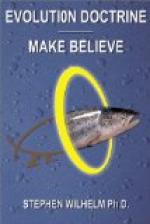The broad and consistent principle underlying these and related facts is this: there is a general correspondence between the differences displayed by the organisms of two regions and the degree of isolation or proximity of these two areas. Thus the disconnected but neighboring areas of the Galapagos Islands and South America support species that resemble each other closely, for the reasons given before; long isolated areas like Australia and its surroundings possess peculiar creatures like the egg-laying mammals, and all of the pouched animals or marsupials with only one or two exceptions like our own American opossum,—a correlation between a geological and geographical discontinuity on the one hand and a peculiarity on the other that reinforces our confidence in the faunal evolutionary interpretation of the facts of distribution.
It is true that the various classes of animals do not always appear with coextensive ranges. The barriers between two groups of related species will not be the same in all cases. A range like the Rocky Mountains will keep fresh-water fish apart, while birds and mammals can get across somewhere at some time. All these things must be taken into account in analyzing the phenomena of distribution, and many factors must be given due attention; but in all cases the reasons for the particular state of affairs in geographical and biological respects possess an evolutionary significance.
Having then all the facts of animal natural history at his disposal, and the uniform principles in each body of fact that demonstrate evolution, it is small wonder that the evolutionist seems to dogmatize when he asserts that descent with adaptive and divergent modification is true for all species of living things. The case is complete as it stands to-day, while it is even more significant that every new discovery falls into line with what is already known, and takes its natural place in the all-inclusive doctrine of organic evolution. Because this explanation of the characteristics of the living world is more reasonable than any other, science teaches that it is true.
IV
EVOLUTION AS A NATURAL PROCESS




